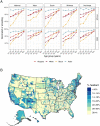The US COVID-19 Trends and Impact Survey: Continuous real-time measurement of COVID-19 symptoms, risks, protective behaviors, testing, and vaccination
- PMID: 34903656
- PMCID: PMC8713763
- DOI: 10.1073/pnas.2111454118
The US COVID-19 Trends and Impact Survey: Continuous real-time measurement of COVID-19 symptoms, risks, protective behaviors, testing, and vaccination
Abstract
The US COVID-19 Trends and Impact Survey (CTIS) is a large, cross-sectional, internet-based survey that has operated continuously since April 6, 2020. By inviting a random sample of Facebook active users each day, CTIS collects information about COVID-19 symptoms, risks, mitigating behaviors, mental health, testing, vaccination, and other key priorities. The large scale of the survey-over 20 million responses in its first year of operation-allows tracking of trends over short timescales and allows comparisons at fine demographic and geographic detail. The survey has been repeatedly revised to respond to emerging public health priorities. In this paper, we describe the survey methods and content and give examples of CTIS results that illuminate key patterns and trends and help answer high-priority policy questions relevant to the COVID-19 epidemic and response. These results demonstrate how large online surveys can provide continuous, real-time indicators of important outcomes that are not subject to public health reporting delays and backlogs. The CTIS offers high value as a supplement to official reporting data by supplying essential information about behaviors, attitudes toward policy and preventive measures, economic impacts, and other topics not reported in public health surveillance systems.
Keywords: COVID-19; SARS-CoV2; survey.
Copyright © 2021 the Author(s). Published by PNAS.
Figures





References
-
- Centers for Disease Control and Prevention, COVID Data Tracker. https://covid.cdc.gov/covid-data-tracker/. Accessed 16 June 2021.
-
- Chan A. T., Brownstein J. S., Putting the public back in public health—Surveying symptoms of Covid-19. N. Engl. J. Med. 383, e45 (2020). - PubMed
-
- United States Census Bureau, Household Pulse Survey (COVID-19). https://www.census.gov/programs-surveys/household-pulse-survey.html. Accessed 16 June 2021.
Publication types
MeSH terms
Substances
Grants and funding
LinkOut - more resources
Full Text Sources
Medical
Miscellaneous

